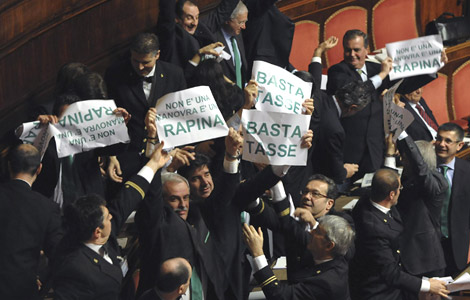Durban outcomes significant milestone
Updated: 2011-12-15 13:32
By Patrick Schroeder (chinadaily.com.cn)
|
|||||||||||
After almost sixteen days of tough negotiations, apparently the longest in the history of the United Nations Framework Convention on Climate Change (UNFCCC), some significant breakthrough was achieved in Durban at the 17th Conference of Parties (COP17). The Parties adopteda "package" which includes as its main elementsan amendment to the Kyoto Protocol (KP), the decision to negotiate a global climate change agreement by 2015 and operationalizing the Green Climate Fund.
The amendment to the KP is an agreement fora second commitment period,starting in 2013. Whether the duration of the second commitment period will be five years or eight years will be decided over the course of the next year.Disappointingly, Japan, Russia and Canada will not take any emission reduction targets for the second commitment period of the KP – so it will only cover less than 20% of global emissions.
The conference in also Durban established a new body under the UNFCCC, the Ad-Hoc Working Group on the Durban Platform for Enhanced Action (AHW-DPEA), to negotiate a new and legally binding global climate change agreement by 2015, covering all emissions from all countries. Although this new global agreement is only planned to come into force from 2020, it nevertheless represents a major step forward.
China entered the Durban negotiations in positive and cooperative spirit, willing to conduct negotiations on a range of issues, including a legally binding agreement. Overall, China did play aconstructive role during the negotiations, although some of the negative western media reporting indicating that China was blocking the process. The US, India and China as largest emitters were frequently put into one and the same boxby the western media and described as "blockers". However, the US was playing a very different role at the negotiations than the large developing countries India and China. Western media in their reporting often failed to take this into account.
China and India were constructively engaging on the issue of a legally binding outcome, although they were at times in strong opposition to the demands of the "EU Road Map", which was also supported by developing countries from the Alliance of Small Island States (AOSIS) and Least Developed Countries. The EU had offered a second commitment period of the Kyoto Protocol, but only under the condition that a new global agreement including all countrieswould need to be agreed on as well.
To achieve this goal the EU tried to play hard ball in Durban,with only limited success. Only in the final hours, when negotiations between EU, India, China and other countries about the right choice of words for different legal options of the new global agreement were carried out in more cooperative spirit, did parties find consensus in the wording ofan "agreed outcome with legal force". The exact form of outcome with legal force is still to be discussed in future negotiations which will conclude in 2015.
The performance of the US, in contrast to China and India, was once again very disappointing. Having thrown obstacles in the way of progress for many years, the US initially did not come to Durban to negotiate for a legally binding agreement. Instead, the US was working the media hard, trying to present itself as a constructive actor in the process. At the same time they were pushing for a weak outcome in the negotiations.This was preventing other countries to move ahead. Even Christiana Figueres, the executive secretary of the UNFCCC, noted the US negotiating behavior as being counter-productive and emphasizedChina's positive contribution to the process saying that "… the US is losing leadership to China."
The Durban conference was also characterized by intense efforts of civil societyorganizations, environmental advocacy groups and youth activists to influence negotiation process and outcomes. The "I love KP" campaign was hugely successful in supporting momentum for the KP's second commitment period. The interruption of the speech of US Climate Envoy by US college student Abigail Borah had significant influence on the perception of the US by the global public.
Despite the good outcomes of the Durban conference, there are still concerns from developingcountries that too much burden has been shifted onto their shoulders. Furthermore, the last-minute compromise on legal form was a missed opportunity to clearly establish equity as a basis for the coming negotiations, and the principle of common but differentiated responsibilities (CBDR) has been undermined to some degree, rather than strengthened.
In one of the final high level segment sessions, NDRC Vice-Minister Xie Zhenhua appropriately expressed concern that many of the developed nations are not doingenough in terms of mitigation action, although they are already legally obliged to do so by the Kyoto Protocol, while many developing countries are already acting.
The agreement reached in Durban represents a major step forward for the multilateral process,however, the agreement will not affect the emissions outlook for 2020 and has postponed decisions on further emission reductions.
From a scientific perspective, the current 2020 mitigation targets are not ambitious enough andglobal mean warming would reach about 3.5°C by 2100 with the current reduction proposals on the table. As reported in the recently published UNEP emissions gap report, current pledges by developed and developing countries will mean that by 2020 global emissions will be 6-11 Gigatonnes of CO2 equivalent higher than a 2°C emissions trajectory.
Especially current pledges by developed countries fall far short of what is needed. Current pledges add up to no more than 12-18% reductions below 1990 by 2020.What environmental groups as well as the Intergovernmental Panel on Climate Change (IPCC) require is that developed countries move into the 25-40% range, as a first step, and subsequently to more than 40% below 1990 by 2020.
Developing countriescan contribute their shareby putting forward National Appropriate Mitigation Actions (NAMAs), including information on the support required, and to increase, as appropriate, current ambition of already pledged NAMAs under the Convention.
Increasing ambition in China for more bottom-up climate change action is supported by Chinese environmental NGOs through the "C+ Initiative". C+ encourages progressive climate actions from all sectors and members of society. Under the C+ framework, companies, schools, urban communities and households, villages as well as individuals can join the initiative. NGOs with expertise in different areas will provide technical support to these actions.
Overall, in Durban the multilateral process was strengthened and more clarity on the legal form of the future agreement exists. Now is the time to further raise ambition and set higher mitigation targets. There is lots of work ahead for all parties in the coming Year of the Dragon and beyond.
Patrick Schroeder (Ph.D.) is international advisor at the China Association for NGO Cooperation (CANGO) where he supports the China Civil Climate Action Network (CCAN).?
Hot Topics
HIV/AIDS, Egypt protest, Thanksgiving, climate change, global economic recovery, home prices, high-speed railways, school bus safety, Libya situation, Weekly photos
Editor's Picks

|

|

|

|

|

|







